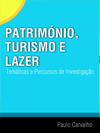Walking, footpaths and heritage in Portugal: between enjoyment and preservation
1.Walking and heritage
The topic related to walking and footpaths has hardly been explored in the national and international literature. This communication has presented the latest facts and figures on walking and footpaths in Portugal, and it has tried to show that the enjoyment resulting from these activities (when planned) can help to develop bonds and values in the context of identifying, safeguarding, exploiting and interpreting heritage.
The pastime of walking along marked trails puts people in close contact with the landscape and “can make people aware of the importance of safeguarding natural and cultural resources, cultivating the well-being and the quality of life of those involved. This activity is particularly attractive in terms of education, science, recreation and tourism” (CALIXTO e DORES, 2008).
Walking has grown in popularity in recent years, partly thanks to major social and cultural changes and to a drive to encourage physical activity, improving well-being and personal image. Another important factor has been the wide-ranging territorial interventions, particularly with respect to renovation, revitalisation and regeneration, in which the State also participated via various departments, making use of a number of territorial management instruments. Such interventions were designed to bring heritage and landscapes closer to citizens and sometimes to develop them, creating more and better social and recreational areas and amenities (PEARCE and BUTLER, 2005).
Walks and walking are important means of motivating an attitude of discovery, preservation and utilisation of (natural, cultural and landscape) heritage sites. In the context of scheduled integrated interventions in leisure, sports, tourism, culture and nature areas they thus contribute to the integrated sustainable development of the territories and their populations alike.
Old paths between villages or which lead to fields, woods and grazing land; streams, too, and abandoned railway lines; pilgrim paths, routes taken by armies defending the country, all these (and others) are part of the memory and identity of regions and they are a historical and cultural heritage that is worth preserving and valuing.
To bring this heritage closer to people and inform them about it, to allow enjoyment of it and stimulate its exploitation, it has to be located, restored and provided with basic conditions for its use. The more important historic routes (or the more ‘typical’ ones, depending on the criteria adopted) should be provided with information and signs, both in situ and through publicity/access media, in cooperation with the people who know the area best.
Several bodies play an important part in creating and maintaining footpaths, viz., sports clubs and federations, mountaineering, camping and tourist associations, central, regional and local government authorities and tourist agencies and operators.
2. Footpaths: walkers and territories
KOUCHNER and LYARD (2001) note that for most people walking is an informal activity, not a sport, and the routes are usually short (two to three hours), not very difficult and circular (starting and finishing in the same place). They mention other characteristics, including walkers’ autonomy (over 90% do not use guides), the presence of women (about 50% of walkers in France and Germany), walking as a family activity, and the fact that walkers and hikers tend to come from the middle and upper social/economic classes.
According to the European Ramblers Association (2009), Europe is covered by a network of 11 Long Distance paths which cross several countries. “These paths total nearly 55000 km and are axes of a huge network that incorporates thousands of kilometres of local routes of varying lengths, and which are combined to cater for different users. Some of them follow historic routes, like the legendary GR65 French trail to Santiago de Compostela” (TOVAR, 2010).
Some European countries have a long tradition of walking, with a huge network of signed paths and excellent information and publicity materials. Austria, France, Germany, Great Britain and Switzerland are particularly advanced in this respect. Denmark, Hungary, Luxembourg and Sweden all have walking routes which also have shelters and other tourist accommodation establishments so that walkers have somewhere to sleep along the way.
The development of walking and designation of public footpaths is relatively new in Portugal. The 1990s is really the reference point, when rules on marking routes were published, the first paths were signed, the first publications appeared and the organisation of the activity started to grow. All in all it can be said that walking in Portugal, taking the number of activities scheduled by various bodies (around 240 in 2008-2009, non-commercial), has achieved significant status as a recreational activity, and is enjoyed increasingly often all over the country. The regions making the most effort in organising walking activities are the North (28%), Lisbon and Vale do Tejo (26%), and the Centre (21%), which together account for 75% of the total. 1780 activities were scheduled in 2009. Since walking is mostly a weekend pursuit, an average of 34 activities are organised per weekend, countrywide, over the year. Similarly, there was a significant growth (over 61%) in the number of scheduled walks between 2007 and 2009 (TOVAR, 2010).
The geographic distribution of walks focuses on the north, south and islands (Madeira and Azores), all of which regions combine mountain environments and areas of considerable natural interest. Within these regions, the most popular areas are: Peneda-Gerês National Park; the Serra da Freita; Idanha-a-Nova and surrounding areas; the municipalities in the Serras de Aire and Candeeiros; the Serra de Sintra and the littoral area of Lisbon; the municipalities of Montemor-o-Novo and Évora, in Alentejo, and the municipalities of Loulé, Tavira and Alcoutim, in Algarve.
There are nearly 3500 km of approved footpaths in Portugal, covering all the country apart from the Azores, where the facilities for this activity are very good, although not approved by the Portuguese Camping and Mountaineering Federation. “In the North there are 1025.6 km, Centre 761.5 km and Algarve 755.8 km of paths, together totalling 2542.9 km of approved footpaths, which is 76% of the total. The total for footpaths is the combined figures for short distance and long distance routes, with most being short distance ones (about 71%), that is, routes that can be done in a day, usually less than 30 km” (TOVAR, 2010). In relation to the latter, the mainland has 98.8% of the number of short distance footpaths and accounts for 99.2% of the total kilometres. The North region has the biggest total of kilometres for short distance routes, followed by the Centre, Algarve, Alentejo and Lisbon and Vale do Tejo. Madeira only has 3 footpaths, totalling 18.8 km.
As with the geographic distribution of the activity, the supply of approved public footpaths is greater in the mountains and areas of considerable natural interest (National Network of Protected Areas and Natura Network 2000). These are the main areas for the potential development of walks as tourist products.
Public footpaths are important in this context as a way of supplementing the tourist experience in a particular destination by being another activity for tourists to enjoy; but they can also be important by being the main tourist product and providing the reason for travelling to a destination.
In conclusion, walking and footpaths can be a mobilising platform for society to enjoy, explore and help to publicising and protecting unique resources and heritage that are, at the end of the day, the mystical spirit of any place. From this standpoint it is an activity of great relevance to the great crusade that consists of getting closer to, involving (and sometimes giving back) and creating enduring bonds between heritage and citizens, through values, and so it should be yet another element in integrating the instruments of territorial management, particularly at local and regional level. They are now a medium for revealing and getting to know landscapes whose value in terms of aesthetics and heritage make them worthy of a visit, and preservation (as areas of biocultural equilibrium).
References
CALIXTO, V. e DORES, A. (coord.) (2008) – Guia de Percursos Pedestres (Algarve). Faro, Região de Turismo do Algarve e Comissão de Coordenação e Desenvolvimento Regional do Algarve.
PEARCE, D. & BUTLER, R. (2005) – Contemporary Issues in Tourism Development. London, Routlege.
KOUCHNER, F. & LYARD, J. (2001) – “A valorização do turismo de passeio pedestre nos territórios rurais – Guia pedagógico para a elaboração e execução de um projecto de passeio pedestre”. Inovação em Meio Rural, Caderno nº. 12, Observatório Europeu Leader (disponível em: http://ec.europa.eu/agriculture/rur/leader2/rural-pt/biblio/walking/walking.pdf, 12-02-2009).
TOVAR, Z. (2010) – Pedestrianismo, Percursos Pedestres e Turismo de Passeio Pedestre em Portugal. Dissertação de Mestrado em Turismo (Gestão Estratégica de Destinos Turísticos) apresentada à Escola Superior de Turismo e Hotelaria do Estoril.
| En eumed.net: |
 1647 - Investigaciones socioambientales, educativas y humanísticas para el medio rural Por: Miguel Ángel Sámano Rentería y Ramón Rivera Espinosa. (Coordinadores) Este libro es producto del trabajo desarrollado por un grupo interdisciplinario de investigadores integrantes del Instituto de Investigaciones Socioambientales, Educativas y Humanísticas para el Medio Rural (IISEHMER). Libro gratis |
15 al 28 de febrero |
|
| Desafíos de las empresas del siglo XXI | |
15 al 29 de marzo |
|
| La Educación en el siglo XXI | |





